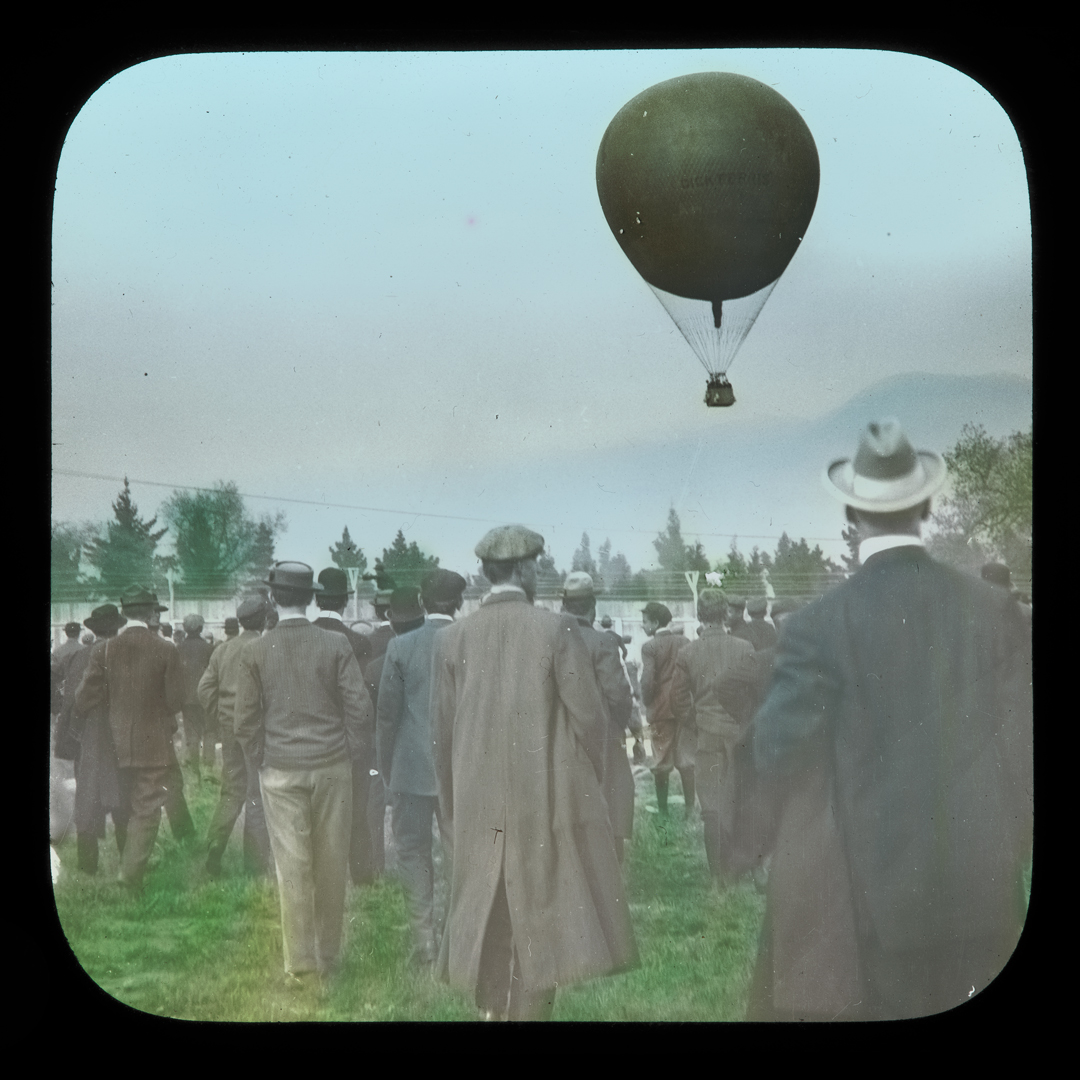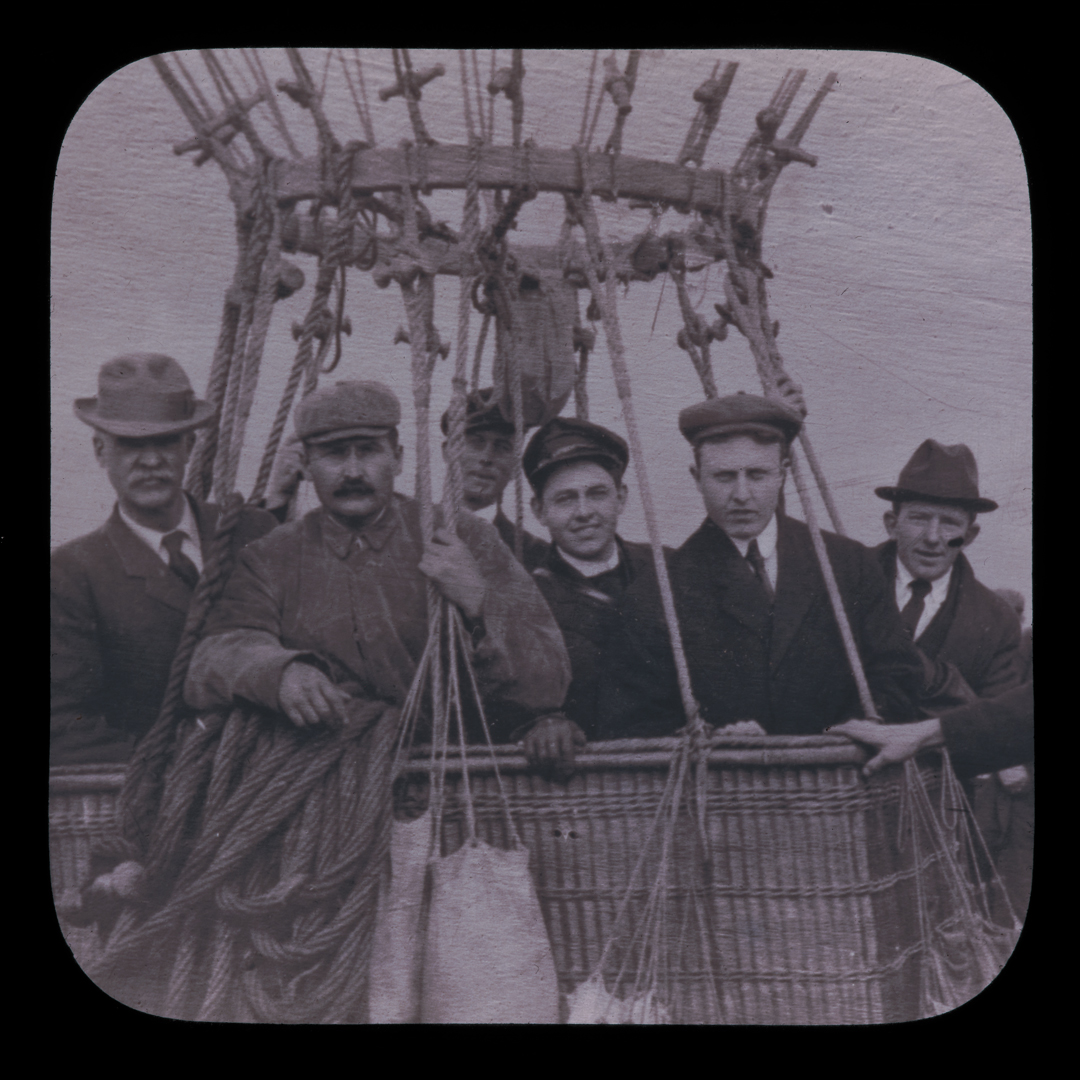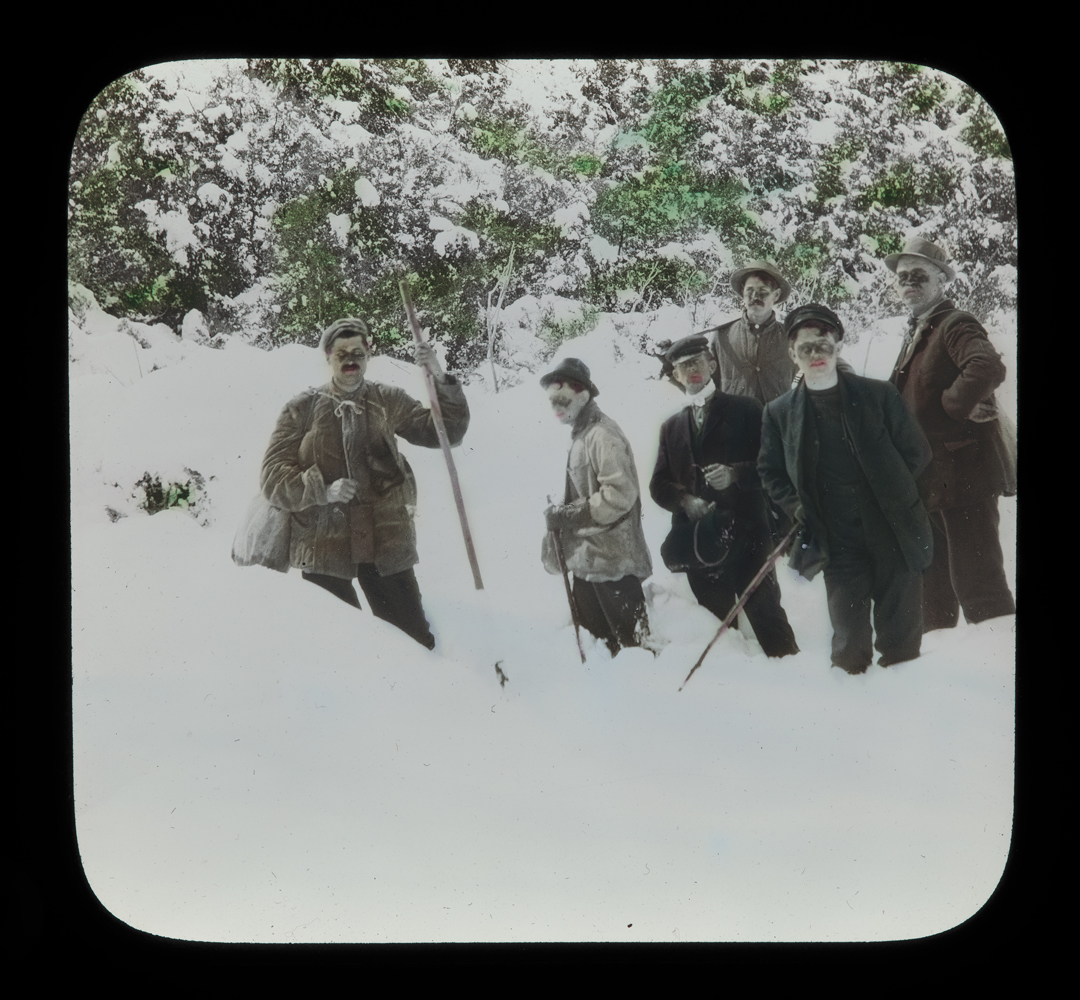
Harold A. Parker, Spectators watch the American ascend, 1909, hand-colored lantern slide. Gift of Joan Palmer, 2014. | The Huntington Library, Art Museum, and Botanical Gardens.
Jason Pearl, a 2023–24 short-term fellow at The Huntington and associate professor of English at Florida International University, is currently working on a book about ballooning and literature in the 18th and 19th centuries. He writes below about a remarkable early 20th-century balloon flight documented through lantern slides in The Huntington’s collection. To tell the story, he draws upon contemporaneous newspaper accounts and a book about the incident titled Perilous Voyage of the Balloon American (1993), by Donald L. Parker, a son of the photographer Harold A. Parker, who was one of the balloon’s passengers.
What may be the first aerial photographs of Pasadena, California, were the product of a risky—almost disastrous—undertaking.
On March 20, 1909, at Tournament Park (now part of the Caltech campus), a balloon called the American rose into the sky and vanished among the clouds. The passengers had paid $25 each for a ride to San Bernardino. But instead of heading east, the balloon caught a wind that sent them high in the air and due north, straight into the San Gabriel Mountains.
The ascent was part of a weeklong “Carnival of Sports” that took place on the Tournament Park grounds, with proceeds going to veterans of the U.S. Civil War. Among the events was a baseball game between the Chicago White Sox and the Los Angeles Angels. There also was a mock battle and a pushball match as well as concerts and burro races. One of the attractions was a balloon launch.
The passengers of the American included Capt. Mueller, a Brazilian aeronaut; Richard Halsted, a Pasadena business leader; Lane Gillam, a guest at a local hotel; Sidney Cray, owner of a pigeon ranch; Harold A. Parker, a photographer; and Edwin Dobschutz, a chauffeur who did not tell his wife of the flight because he thought it would be brief.

Harold A. Parker, Passengers of the American before liftoff, 1909, lantern slide. From left: Lane Gillam, Capt. Mueller, Sidney Cray, Richard Halsted, Harold A. Parker, and Edwin Dobschutz. Gift of Joan Palmer, 2014. | The Huntington Library, Art Museum, and Botanical Gardens.
The journey was tense from the start. Mueller told the group to leave behind their matches and cigarettes. They might have been tempted to light up while taking in the view, but a mere spark could have ignited the gas that filled the balloon. Then the drag rope, used for control, got caught on some telephone wires. By the time the rope was cut, the wind had changed direction, so that a strong gust lifted the party high in the clouds and blew them toward the mountains.
For Parker, it was a chance, nonetheless, to photograph Pasadena from the air. Though still in the early stages of development, with wide swaths of open land, the city and its outlines are nevertheless visible in his photos. One of the pictures shows Colorado Street (now Colorado Boulevard). Another displays the mountains in the distance. Unfortunately, the balloon was in motion, and shutter speeds were slow, so the images are somewhat blurry but still extraordinary for their time.

Harold A. Parker, Colorado Street, Pasadena: aerial view as seen from the American, 1909, hand-colored lantern slide. This is the view to the west. The second cross street is Lake Avenue. Gift of Joan Palmer, 2014. | The Huntington Library, Art Museum, and Botanical Gardens.
Flying toward the mountains, Mueller looked for but could not find a place to land. There were campfires and brushfires in the foothills that threatened to ignite the balloon. So they kept flying and went in and out of the clouds. At last, Mueller saw a peak with a small space for landing. He pulled the valve to let out gas. The balloon caved in and formed a parachute.
Finally, on Mueller’s command, the group threw out the ballast and many of their belongings to slow the descent. They crashed on a ledge in cold, wet weather with little food and insufficient clothing. Luckily, Dobschutz, the chauffeur, found a match in one of his pockets, and the group made a fire to keep warm.
Meanwhile, the affair made headlines across the country. The Chicago Record-Herald ran the story under the headline: “BALLOON AND SIX MEN LOST IN THE MOUNTAINS.” The New York World announced: “BALLOON MISSING IN BIG STORM IN CALIFORNIA.” The Minneapolis Tribune declared: “6 AERONAUTS LOST IN DESERT WILDS.”

Harold A. Parker, Aerial view looking north toward the mountains, Pasadena, 1909, hand-colored lantern slide. Rising in the distance are the San Gabriel Mountains. Gift of Joan Palmer, 2014. | The Huntington Library, Art Museum, and Botanical Gardens.
But the travelers were resilient. They trudged through wind and snow, chanting, “Move on!” Along the way, the party was taken in by Delos and Lillie Colby, who owned a ranch for hunters and fishers. There, the group got much-needed food and shelter. Then, farther along, they were found by a search party near an abandoned lodge called Switzer’s Camp.
After three harrowing days, the men finally returned to the city. The Pasadena Daily News ran the headline: “ENTIRE BALLOON PARTY SAFE.” Gillam explained to a Los Angeles Times reporter: “It was a case of strive and live, or give up and die, and we preferred to live.” Asked when he would go up next, Gillam admitted, “Not right away.” Mueller, in the same news account, reflected, “To say that we are thankful is putting it in very mild terms. Our escapade is one that will never be forgotten by any member in the party, and our belief in a Divine Providence has certainly been strengthened wonderfully within the past seventy-two hours.”

Harold A. Parker, Scene in the San Gabriel Mountains where the balloon landed, 1909, hand-colored lantern slide. Gift of Joan Palmer, 2014. | The Huntington Library, Art Museum, and Botanical Gardens.
The mishap has not passed entirely from memory, but the dangers and difficulties of early aerial photography certainly have. We call up maps on our smartphones and use drones to capture a bird’s-eye view of the landscape. What may be the earliest aerial photographs of Pasadena came at the cost of great hardship. But Mueller and company lived to tell the tale. And Parker developed the photographs.
You can see more photographs taken during this 1909 balloon incident at the Huntington Digital Library.
Jason Pearl is an associate professor of English at Florida International University and a 2023–24 short-term fellow at The Huntington.
